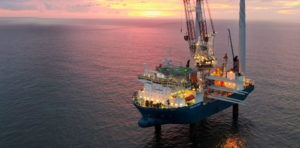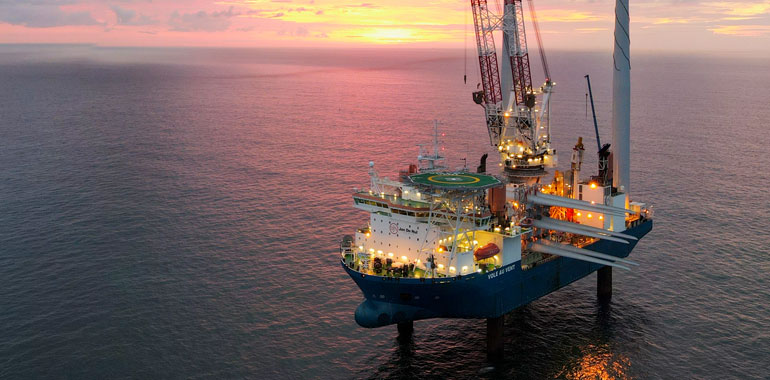
President Joe Biden wants the United States to generate enough offshore wind energy to power 10 million homes by 2030, and his administration is looking to assist the burgeoning sector.
Specifically, the administration has proposed $3 billion in federal loans, quicker permitting and the establishment of an offshore wind power priority zone off New York and New Jersey. The plan also calls for $230 million in port upgrades to support and facilitate large-scale offshore wind projects.
The administration in May approved Vineyard Wind, the first major U.S. offshore wind project, which aims to build roughly 60 turbines 14 miles off the Massachusetts coast. A network of East Coast ports are preparing their facilities to support these projects as they move toward construction.
“I think, as with anything, it would be better if we were further along,” said Matthew Tremblay, senior vice president of global offshore markets for ABS. “The investment is happening. … I think that as we see development happen, the ports will rise to meet the needs.”
Not any port can be a port for the wind energy industry. Turbine components require an infrastructure that can accommodate their massive size and weight. Blades extending 120 feet and nacelles weighing 400 tons cannot be trucked on highways. As such, ports need space to manufacture them on site or assemble them after they arrive by water.
Once on ships, many parts are delivered standing, so bridges, even tall ones, could render a port unsuitable. The heavy materials call for greater ground-bearing capacity than most ports have. Typical capacities in U.S. ports are five tons per square meter, according to the Department of Energy. Monopiles, the skyscraper-like foundation of wind turbines, require bearing capacities that exceed 20 tons per square meter. Then there is the task of creating space for a new industry that deals in gigantic parts while still meeting the needs of other port users.
Rhode Island’s Port of Providence, the launching site for the Block Island Wind Farm completed in late 2016, had some built-in advantages. There are no bridges blocking any area over the port, and the soil can support turbine parts. “Because of use of the port over the years, we had an opportunistic bearing capacity,” said Chris Waterson, general manager of Waterson Terminal Services, which operates the Port of Providence.
Still, with no manufacturing space, turbine components had to be shipped from Europe and assembled there. Ørsted U.S. Offshore Wind and the utility Eversource plan to build a $24 million manufacturing facility at the port.
The installation of wind farms on a scale to meet the Biden administration’s goals will require a network of capable ports rather than a single hub. A report from the American Bureau of Shipping (ABS) identified several ports that may be viable for offshore wind use, and other sites whose owners or operators are preparing them to create domestic offshore wind infrastructure. These include Tradepoint Atlantic in Maryland, the New Jersey Wind Port, the Brayton Point Commerce Center in Somerset, Mass., and the nearby New Bedford Marine Commerce Terminal. Others include the ports of Bridgeport, New London and Norfolk in Connecticut.
Tradepoint Atlantic is a former steel mill turned into a 3,300-acre logistics center on a peninsula in Baltimore County. Ørsted has plans to modify the ground to increase bearing capacity and develop a staging center, with equipment able to move turbine parts.
The 200-acre New Jersey Wind Port, built on an artificial island in Salem County and scheduled for completion in 2023, represents the state’s attempt to capitalize on a geographic advantage that puts it in the center of the span where most of the nation’s wind farms will be built.
“The [New Jersey Economic Development Authority] did a lengthy analysis,” said Jonathan Kennedy, managing director of the NJEDA. “We looked at 40 sites and narrowed it based on technical specifications.”
Plans include a 25-acre manufacturing area and a 30-acre marshaling yard where turbines can be assembled. Kennedy hopes it will be a hub for projects across the Eastern Seaboard.
Brayton Point Commerce Center, located at the tip of Somerset, Mass., in Mount Hope Bay, was previously home to a coal-fired power plant that closed in 2017. Last year, a brownfield redeveloper completed upgrades to adapt it into a wind energy hub. The facility can support heavy-lift port operations and receive deep-draft vessels.
The 29-acre New Bedford Marine Commerce Terminal was approved a decade ago and built specifically to be the nation’s first energy hub port. The semi-public Massachusetts Clean Energy Center runs the facility. It will handle most of the needs for the Vineyard Wind project.
“The idea of hubs is extremely exciting because it has created collaboration between the states,” said Ross Gould, vice president for supply chain development for the Business Network for Offshore Wind. “It’s a great way to create a domestic supply chain.”
The Port of Virginia, in Norfolk, also offers promise. The port “is 30 minutes to the open ocean, never freezes and still has plenty of other land along the rivers for manufacturing and assembly,” the ABS report notes. Also, the port has no air draft or horizontal clearance restrictions.
Other ports are getting upgrades in partnership with the wind energy companies. Ørsted and Eversource have an agreement with the city of New London, in Connecticut, to modify its port for wind development. On the other end of the state, Vineyard and New York City-based McAllister Towing and Transportation plan to create a 18.3-acre waterfront industrial property in Bridgeport that can do some of the outfitting of wind turbine pieces. Vineyard Wind plans to use Bridgeport as a port in support of its 800-MW project.
Most wind energy activity is currently limited to the East Coast, although authorities are exploring the viability of similar projects in the Gulf of Mexico. The deeper waters and environmental protections of the West Coast make it unsuitable for wind turbine installation. However, floating farms are realistic possibilities.
“I think [port operators] still view it as being a few years out,” said Tremblay, with ABS. Floating wind warms offer energy generation capabilities comparable to in-ground ones, he said. However, they are more expensive, as operators have to moor them. That segment of the industry needs to “be brought up to scale” before port owners and other stakeholders see a profit after the expensive and costly upfront investment. •

